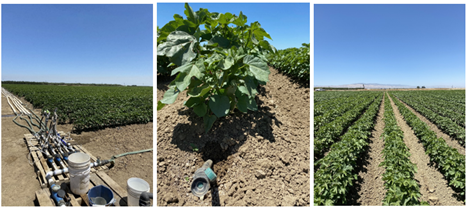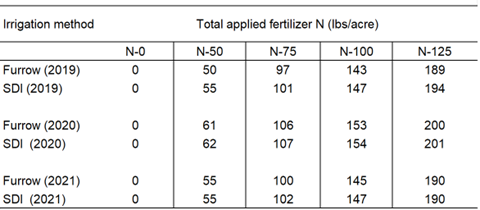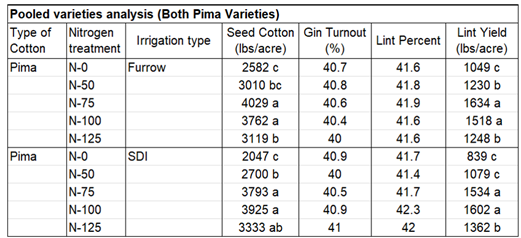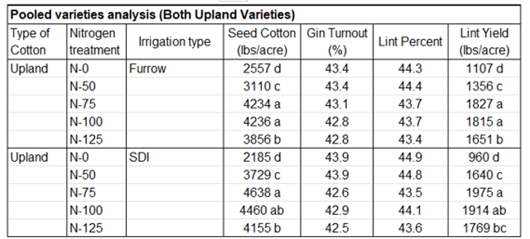Note: This is part of a Research Update series that highlights projects funded by the California Department of Food and Agriculture (CDFA) Fertilizer Research and Education Program (FREP) annual grant program.
Project Title: Pima Cotton Nitrogen Management, Uptake, Removal – Impacts of Varieties, Subsurface Drip and Furrow Irrigation
Project Lead: Robert Hutmacher, Extension Specialist, University of California (UC), Davis, UC West Side Research and Extension Center (REC).
Project Status: Complete
Project location: Kern, Kings, Fresno, and Merced county-sites
Overview: This FREP-funded project evaluated the impacts of nitrogen (N) application rates, varieties, and irrigation methods (subsurface drip versus furrow) on total plant N uptake and harvest removal for Pima cotton and a widely planted Upland variety in the Central Valley. In addition, to better understand Pima N requirements, this project determined total aboveground plant N uptake at early open-boll timing, and N removal with harvest in three grower fields.
Highlights
- Both Pima and Upland cultivars had similar yield responses to fertilizer N rates under furrow and subsurface drip irrigation
- The most N-deficient treatments resulted in lower yields and had significantly lower seed N concentrations and removal
- There were no significant, consistent differences in seed N concentrations between Upland versus Pima varieties
- Yields peaked for both Pima and Upland cultivars at N application rates based on 75% and 100% of the N requirement, while fertilizing at 125% of the estimated N requirement tended to reduce yield.
- No trends toward impacts of N treatments and irrigation methods on important fiber quality parameters were observed (data not presented in this blog post)
Background
San Joaquin Valley cotton growers aim for high yields to cover increasing production costs such as irrigation water and fertilizer. This high yield goal can serve as a significant incentive to overapply N fertilizer to increase the likelihood of achieving desired yields. However, overapplication of N fertilizer has resulted in groundwater nitrate contamination and consequently triggered water quality regulations; thus, highlighting the need for implementation of efficient irrigation and N management practices. There is very limited data on N responses, uptake, and harvest removal for Pima cotton, a relatively large acreage crop for the Central Valley. The goal of this project was to evaluate impacts of N application rates, variety, and irrigation methods on cotton yield and yield components, total plant N uptake, and harvest removal of Pima and Upland cotton cultivars.
Approach
Researchers conducted two three-year field studies at the UC West Side Research and Extension Center (REC) and grower fields in the San Joaquin Valley. At the UC West Side site, small-plot studies were implemented on cotton N uptake as a function of N application rate and variety under subsurface and drip irrigation, including two Pima varieties versus two Upland varieties for comparison. In grower fields, (Merced, Kern, and Fresno counties) researchers focused on determining total plant N uptake and removal with seed and gin trash in Pima cotton varieties. All grower site locations were under furrow or level-basin irrigation.

Left: Irrigation design supplying water to the subsurface drip treatment plot; Middle: Subsurface drip line with flush valve buried; Right: Cotton plots with beds running ~350 feet (FREP field visit, West Side REC, June 2020).
Researchers collected early season and end-of-season soil samples for evaluation of soil nitrate-N levels. Nitrogen removal, uptake, and yield responses of Pima and Upland varieties were measured (plant tissue samples) at five N application rates, representing 0, 50, 75, 100 and 125% of estimated N requirements. Estimated fertilizer needs were adjusted for early season residual soil nitrate, with the target amount based on a realistic yield goal for the site. Based on prior field experiments, researchers established 185 lbs N/ac as the target fertilizer application at the 100% level treatment for a 2000 lbs lint/acre yield goal. The actual N fertilizer applications for each rate are shown in Table 1.
Table 1. Applied N rates in furrow and subsurface drip (SDI) irrigated N rate trials at the UC West Side REC in 2019, 2020 and 2021.

Findings
Data presented in this blog post are averaged over three growing seasons and Pima and Upland cotton varieties.
Seed cotton and lint yields: In all three years and under both drip and furrow irrigation methods, seed cotton and lint yields for Pima and Upland cotton varieties peaked at N-75 or N-100 rates (Tables 1 and 2). With Pima varieties, seed cotton and lint yields peaked at N-75 rate in furrow irrigated plots with no significant difference between N-75 and N-100 rates (Table 1). In subsurface drip irrigation, the highest seed cotton and lint yields were observed at N-100 rate, which didn’t differ significantly compared to N-75 rate (Table 1). The highest N rate (N-125) either reduced yields (furrow irrigation) or did not have a significant impact on yield under subsurface drip irrigation, although a non-significant trend toward lower yields at N-125 rate also existed (Table 1).
Table 1. Pooled varieties yield analysis (seed cotton yield, gin turnout, lint percent, and lint yield) for Pima cotton varieties at the West Side REC site. Yield values followed by a different letter were significantly different at the P<0.05 level.

A similar trend to the Pima cotton was observed in Upland varieties, where the highest seed cotton and lint yields were obtained at N-75 and N-100 rates under both irrigation methods (Table 2). Increasing the N rate from N-100 to N-125 resulted in a 9 percent decrease in both seed cotton and lint yields in furrow irrigated plots (Table 2). Also, plants fertilized at N-125 rate under subsurface drip irrigation showed a 6.8 and 7.5 percent decrease in seed cotton and lint yields respectively, compared to the N-100 rate (Table 2).
Table 2. Pooled varieties yield analysis (seed cotton yield, gin turnout, lint percent, and lint yield) for Upland cotton varieties at the West Side REC. Yield values followed by a different letter were significantly different at the P<0.05 level.

Seed cotton yield and lint yield decreases at the highest N fertilizer rate (N-125) in both Pima and Upland varieties can be explained by additional vegetative growth at the expense of suppressed reproductive tissue growth (bolls/seed/lint).
Seed and gin trash N removal: Across different sites, cultivars, and years, seed N removal with harvest averaged 48.5 lbs N/Ton of seed cotton. The most N-deficient treatments, N-0 and N-50, which also had lower yields, had significantly lower seed N concentrations (in the 3.4% to 3.7% range) than the higher N application treatments, which were mostly in the 4% to 4.5% range. According to the research team, these values might vary to some degree with cultivar and site yield ranges.
There were no significant, consistent differences in N concentrations between Upland versus Pima varieties.
Gin trash nitrogen concentrations averaged 1.96% across different sites, cultivars, and years. It is to be expected that the range of quantities of gin trash will be highly variable by location, physical operation of the harvester, crop condition at harvest, and efficacy of defoliation efforts.
Seed cotton yield, seed N concentration, harvest N removal, and gin trash N concentration values averaged over irrigation methods and cotton cultivars are presented in Table 3.
Table 3. Grower and West Side REC variety trial sites for seed cotton yield, seed N concentration and harvest N removal, and gin trash N concentration averages in 2019, 2020, and 2021 for Pima cotton varieties.

Aboveground plant N uptake: The total amount of N contained in aboveground plant parts (stem and branches, leaf, burs and seed) ranged from about 105 lbs N/acre in the lowest yielding plots (less than 850 lbs lint/acre, control (N-0) plots) to a high of over 300 lbs N/acre in the N-125 rate. Aboveground biomass weights (dry) ranged from a low of less than 6000 lbs/acre to many plots in the 8,000 to 11,000 lbs/acre range.
Soil nitrate changes: Overall, soil nitrate levels indicated a reduction (in lbs nitrate-N/acre) from planting time to harvest, indicating a net reduction in soil nitrate-N (data not shown in this blog post). Such a reduction could indicate plant uptake and use, or it could result from leaching or denitrification processes. Given the study sites soil type (clay loam) and irrigation methods and N rates used, the research team assumes that the observed changes in soil nitrate-N between planting and harvest were largely plant utilization of soil N.
Project Impacts
Results of this study, with many more measurement locations and multiple current commercial varieties, serve to verify that the N removal levels and fertilizer N rate responses in Pima cotton are quite similar to those more broadly available for Upland cotton under irrigated conditions. Such information improves the ability of growers and consultants to better match fertilization application amounts with crop removal levels under conditions with profitable yields.
This blog post presents a summary of this project and some of its findings and does not include all the data collected in this study. To receive the complete report for this project contact FREP at FREP@cdfa.ca.gov


